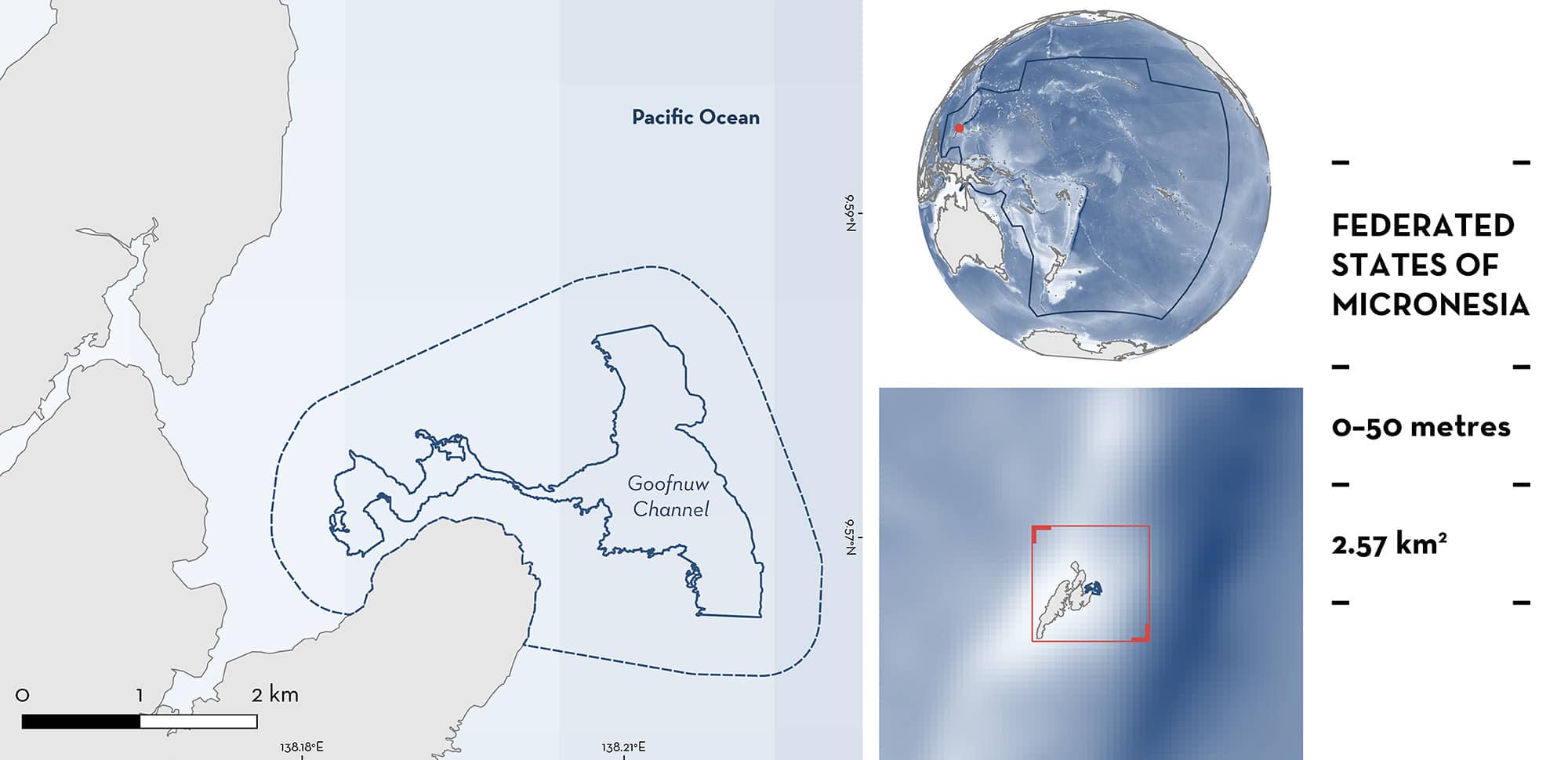ISRA FACTSHEETS
ISRA FACTSHEETS
NEW ZEALAND & PACIFIC ISLANDS REGION
Goofnuw Channel
Summary
Goofnuw Channel is located in the northeast of the island of Yap in the Federated States of Micronesia. The opening of the channel leads to an inner lagoonal system surrounded by mangroves. The substrate in the channel consists of sand, rock, and coral reefs. Within this area there are: threatened species (e.g., Reef Manta Ray Mobula alfredi); resting areas (Whitetip Reef Shark Triaenodon obesus); and undefined aggregations (Reef Manta Ray).
Download factsheet
Goofnuw Channel
DESCRIPTION OF HABITAT
Goofnuw Channel is located in the northeast of the island of Yap in the Federated States of Micronesia. The trade wind season in Micronesia runs from December–April, while the rainy and typhoon season spans from May–November. Goofnuw Channel experiences strong currents and wave action during high winds and trade wind seasons, rendering it inaccessible for diving for most of the year (J Hartup pers. obs 2024). The opening of the channel leads to an inner lagoonal system surrounded by mangroves. The substrate in the channel consists of sand, rock, and coral reefs. An increase in wave height displaces water within the shallow lagoon system and creates outgoing currents even during incoming tides (Manta Ray Bay Resort 2024). Fish spawning aggregations coincide with the outgoing tides (J Hartup pers. obs. 2024).
This Important Shark and Ray Area is benthic and pelagic and is delineated from inshore and surface waters (0 m) to 50 m based on the bathymetry of the area.
CRITERION A
VULNERABILITY
Two Qualifying Species considered threatened with extinction according to the IUCN Red List of Threatened Species regularly occur in the area. These are the Vulnerable Whitetip Reef Shark (Simpfendorfer et al. 2020) and Reef Manta Ray (Marshall et al. 2022).
CRITERION C
SUB-CRITERION C3 – RESTING AREAS
Goofnuw Channel is an important resting area for one shark species.
Between 2010–2024, scientific dive surveys were conducted in the area (J Hartup pers. obs. 2024). In total, 341 surveys were conducted around the island of Yap with 10.6% of surveys in the area (n = 36). Whitetip Reef Sharks were observed during ~75% of surveys in the area, always resting on the sandy substrate in groups of 3–4 individuals. While Whitetip Reef Sharks were observed on surveys in other locations around the island of Yap, they were generally swimming on their own, rather than resting in groups, highlighting the importance of this area for resting purposes for this species (J Hartup pers. obs. 2024).
CRITERION C
SUB-CRITERION C5 – UNDEFINED AGGREGATIONS
Goofnuw Channel is an important area for undefined aggregations of one ray species.
Reef Manta Rays regularly visit two cleaning stations within the area: one deeper site (~10 m depth) and one shallower site (~3 m depth; J Hartup pers. obs. 2024). Between 2013 and 2017, a logbook of sightings was maintained around Yap and recorded 5,240 interactions with Reef Manta Rays. From 161 dives within the area during this period, dive guides logged 654 interactions with Reef Manta Rays (12.5% of total observations around Yap). An average of 2.5 Reef Manta Rays were observed on each dive, ranging between 1–8 individuals (Micronesia Conservation Coalition unpubl. data 2024). Almost all observations are of Reef Manta Rays attending cleaning stations in the area (97% of sightings), however, there were 20 observations of feeding behaviour (3%), suggesting there are occasional pulses of productivity in the area that lead to feeding aggregations. Dives in the area were mostly carried out between June–August, resulting in a seasonal bias to the sighting data. Access to the site is limited during trade winds (December–April), so it is unknown if Reef Manta Rays use the site year-round.
In addition to logbook records, from June–August between 2010–2024, 36 scientific dive surveys were conducted in the area. Surveys recorded 57 Reef Manta Ray sightings in Goofnuw Channel (J Hartup unpubl. data 2024), with 86% (n = 49) of observations of cleaning station attendance and the remaining 14% (n = 8) of observations of Reef Manta Rays feeding. There were 2–3 individuals present during each observation. Further information is required to understand the function and nature of these aggregations.
Download factsheet
SUBMIT A REQUEST
ISRA SPATIAL LAYER REQUEST
To make a request to download the ISRA Layer in either a GIS compatible Shapefile (.shp) or Google Earth compatible Keyhole Markup Language Zipped file (.kmz) please complete the following form. We will review your request and send the download details to you. We will endeavor to send you the requested files as soon as we can. However, please note that this is not an automated process, and before requests are responded to, they undergo internal review and authorization. As such, requests normally take 5–10 working days to process.
Should you have questions about the data or process, please do not hesitate to contact us.


